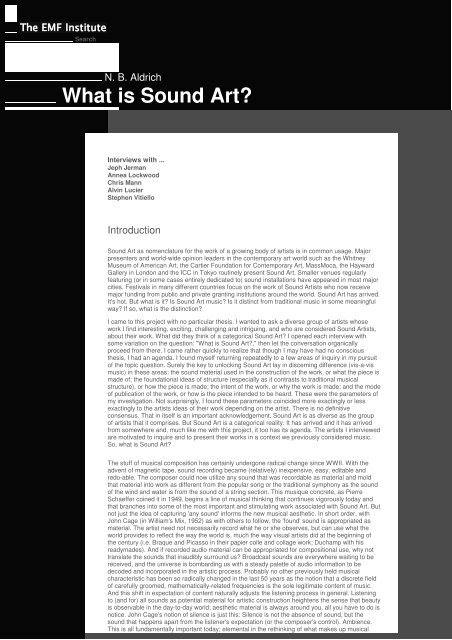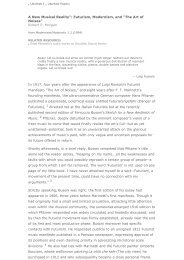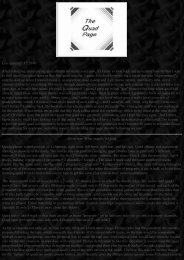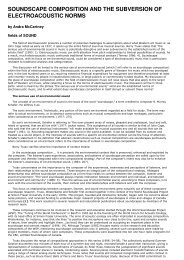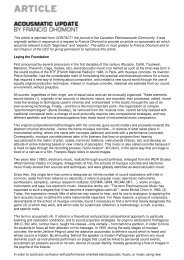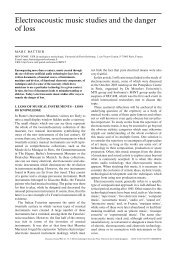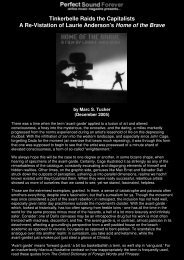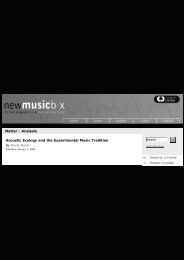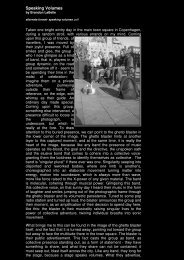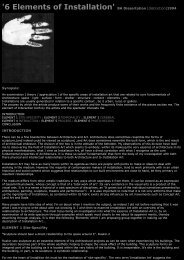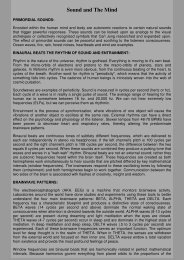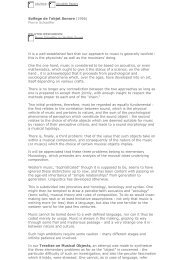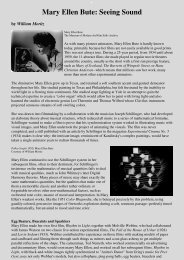Aldrich-2003-What is Sound Art.pdf - An International Archive of ...
Aldrich-2003-What is Sound Art.pdf - An International Archive of ...
Aldrich-2003-What is Sound Art.pdf - An International Archive of ...
Create successful ePaper yourself
Turn your PDF publications into a flip-book with our unique Google optimized e-Paper software.
SearchN. B. <strong>Aldrich</strong><strong>What</strong> <strong>is</strong> <strong>Sound</strong> <strong>Art</strong>?Interviews with ...Jeph Jerman<strong>An</strong>nea LockwoodChr<strong>is</strong> MannAlvin LucierStephen VitielloIntroduction<strong>Sound</strong> <strong>Art</strong> as nomenclature for the work <strong>of</strong> a growing body <strong>of</strong> art<strong>is</strong>ts <strong>is</strong> in common usage. Majorpresenters and world-wide opinion leaders in the contemporary art world such as the WhitneyMuseum <strong>of</strong> American <strong>Art</strong>, the Cartier Foundation for Contemporary <strong>Art</strong>, MassMoca, the HaywardGallery in London and the ICC in Tokyo routinely present <strong>Sound</strong> <strong>Art</strong>. Smaller venues regularlyfeaturing (or in some cases entirely dedicated to) sound installations have appeared in most majorcities. Festivals in many different countries focus on the work <strong>of</strong> <strong>Sound</strong> <strong>Art</strong><strong>is</strong>ts who now receivemajor funding from public and private granting institutions around the world. <strong>Sound</strong> <strong>Art</strong> has arrived.It's hot. But what <strong>is</strong> it? Is <strong>Sound</strong> <strong>Art</strong> music? Is it d<strong>is</strong>tinct from traditional music in some meaningfulway? If so, what <strong>is</strong> the d<strong>is</strong>tinction?I came to th<strong>is</strong> project with no particular thes<strong>is</strong>. I wanted to ask a diverse group <strong>of</strong> art<strong>is</strong>ts whosework I find interesting, exciting, challenging and intriguing, and who are considered <strong>Sound</strong> <strong>Art</strong><strong>is</strong>ts,about their work. <strong>What</strong> did they think <strong>of</strong> a categorical <strong>Sound</strong> <strong>Art</strong>? I opened each interview withsome variation on the question: "<strong>What</strong> <strong>is</strong> <strong>Sound</strong> <strong>Art</strong>?," then let the conversation organicallyproceed from there. I came rather quickly to realize that though I may have had no consciousthes<strong>is</strong>, I had an agenda. I found myself returning repeatedly to a few areas <strong>of</strong> inquiry in my pursuit<strong>of</strong> the topic question. Surely the key to unlocking <strong>Sound</strong> <strong>Art</strong> lay in d<strong>is</strong>cerning difference (v<strong>is</strong>-a-v<strong>is</strong>music) in these areas: the sound material used in the construction <strong>of</strong> the work, or what the piece <strong>is</strong>made <strong>of</strong>; the foundational ideas <strong>of</strong> structure (especially as it contrasts to traditional musicalstructure), or how the piece <strong>is</strong> made; the intent <strong>of</strong> the work, or why the work <strong>is</strong> made; and the mode<strong>of</strong> publication <strong>of</strong> the work, or how <strong>is</strong> the piece intended to be heard. These were the parameters <strong>of</strong>my investigation. Not surpr<strong>is</strong>ingly, I found these parameters coincided more exactingly or lessexactingly to the art<strong>is</strong>ts ideas <strong>of</strong> their work depending on the art<strong>is</strong>t. There <strong>is</strong> no definitiveconsensus. That in itself <strong>is</strong> an important acknowledgement. <strong>Sound</strong> <strong>Art</strong> <strong>is</strong> as diverse as the group<strong>of</strong> art<strong>is</strong>ts that it compr<strong>is</strong>es. But <strong>Sound</strong> <strong>Art</strong> <strong>is</strong> a categorical reality. It has arrived and it has arrivedfrom somewhere and, much like me with th<strong>is</strong> project, it too has its agenda. The art<strong>is</strong>ts I interviewedare motivated to inquire and to present their works in a context we previously considered music.So, what <strong>is</strong> <strong>Sound</strong> <strong>Art</strong>?The stuff <strong>of</strong> musical composition has certainly undergone radical change since WWII. With theadvent <strong>of</strong> magnetic tape, sound recording became (relatively) inexpensive, easy, editable andredo-able. The composer could now utilize any sound that was recordable as material and moldthat material into work as different from the popular song or the traditional symphony as the sound<strong>of</strong> the wind and water <strong>is</strong> from the sound <strong>of</strong> a string section. Th<strong>is</strong> musique concrete, as PierreSchaeffer coined it in 1949, begins a line <strong>of</strong> musical thinking that continues vigorously today andthat branches into some <strong>of</strong> the most important and stimulating work associated with <strong>Sound</strong> <strong>Art</strong>. Butnot just the idea <strong>of</strong> capturing 'any sound' informs the new musical aesthetic. In short order, withJohn Cage (in William's Mix, 1952) as with others to follow, the 'found' sound <strong>is</strong> appropriated asmaterial. The art<strong>is</strong>t need not necessarily record what he or she observes, but can use what theworld provides to reflect the way the world <strong>is</strong>, much the way v<strong>is</strong>ual art<strong>is</strong>ts did at the beginning <strong>of</strong>the century (i.e. Braque and Picasso in their papier colle and collage work; Duchamp with h<strong>is</strong>readymades). <strong>An</strong>d if recorded audio material can be appropriated for compositional use, why nottranslate the sounds that inaudibly surround us? Broadcast sounds are everywhere waiting to bereceived, and the universe <strong>is</strong> bombarding us with a steady palette <strong>of</strong> audio information to bedecoded and incorporated in the art<strong>is</strong>tic process. Probably no other previously held musicalcharacter<strong>is</strong>tic has been so radically changed in the last 50 years as the notion that a d<strong>is</strong>crete field<strong>of</strong> carefully groomed, mathematically-related frequencies <strong>is</strong> the sole legitimate content <strong>of</strong> music.<strong>An</strong>d th<strong>is</strong> shift in expectation <strong>of</strong> content naturally adjusts the l<strong>is</strong>tening process in general. L<strong>is</strong>teningto (and for) all sounds as potential material for art<strong>is</strong>tic construction heightens the sense that beauty<strong>is</strong> observable in the day-to-day world; aesthetic material <strong>is</strong> always around you, all you have to do <strong>is</strong>notice. John Cage's notion <strong>of</strong> silence <strong>is</strong> just th<strong>is</strong>: Silence <strong>is</strong> not the absence <strong>of</strong> sound, but thesound that happens apart from the l<strong>is</strong>tener's expectation (or the composer's control). Ambience.Th<strong>is</strong> <strong>is</strong> all fundamentally important today; elemental in the rethinking <strong>of</strong> what makes up musical
<strong>of</strong> the same activity. Just as the notion that the sound <strong>of</strong> traffic or the wind <strong>is</strong> musically on par withthe sound <strong>of</strong> the guitar or clarinet <strong>is</strong> no stretch for the post-Cagean musician. The landscape <strong>of</strong>audio composition today <strong>is</strong> as broad and rich as it has ever been and the art<strong>is</strong>ts working in thatlandscape utilize many new and fascinating ideas in their pursuits, challenging traditional notions<strong>of</strong> music, l<strong>is</strong>tening and awareness while creating new compositional standards and aestheticmilestones as they go.I would like to extend my most sincere thanks to the art<strong>is</strong>ts who conceded to participate in th<strong>is</strong>inquiry. The thought and care and time they <strong>of</strong>fered was gracious and the ideas and experiencesrelayed are enlightening.N. B. <strong>Aldrich</strong>August 13, <strong>2003</strong>Brooks, ME|||Home |Copyright © 2005 Electronic Music Foundation, Ltd.


